Key Takeaways
- Stretching, crab walks, and planks are no-equipment exercises that can strengthen core muscles in children.
- Game-based activities like twister and hop ball bouTwisterake core strengthening enjoyable and engaging for kids.
- Playground activities like swinging on monkey bars and climbing ladders effectively engage the core muscles.
- Simple bodyweight exercises such as leg lifts and bridges can be incorporated into daily routines for core strengthening.
Understanding Core Muscles in Children
To fully grasp the significance of activities that strengthen core muscles, it is necessary to understand what core muscles are in children and their pivotal role in their physical development. Children’s Core muscles encompass the abdomen, back, and pelvis muscles. These muscles have the crucial function of supporting posture and facilitating movement. They form the basis for all physical activities a child engages in, from simple tasks like sitting and standing to complex ones like running and jumping.
Developing core strength in early childhood is essential as it enhances balance and coordination and augments overall physical abilities. Activities that engage the core muscles are vital in promoting healthy development and physical literacy in children. Conversely, core muscle weakness could lead to detrimental consequences such as poor posture, decreased stability, and difficulty with motor skills. Hence, it becomes imperative to integrate simple yet effective core-strengthening activities into a child’s routine. Such activities can help children engage their core muscles, supporting their physical development and preparing them for more advanced motor tasks.
Importance of Core Muscle Strength
Given their pivotal role in physical activities, core muscle strength in young children is not an aspect of development to be overlooked. Core stability is essential for maintaining proper posture and balance and fostering physical dexterity. This strength forms the bedrock of child development, mainly in gross motor skills. Lacking core muscle strength may result in poor posture, diminished balance, and potential challenges in performing gross motor tasks.
Core exercises for kids are designed to fortify these vital muscles, promoting:
- Enhanced motor skills: Core muscle strength underpins movement coordination and body awareness, which are crucial.
- Improved posture and balance: A strong core stabilizes the body, enabling children to maintain upright sitting positions without fatigue.
Recognizing Weak Core Muscles
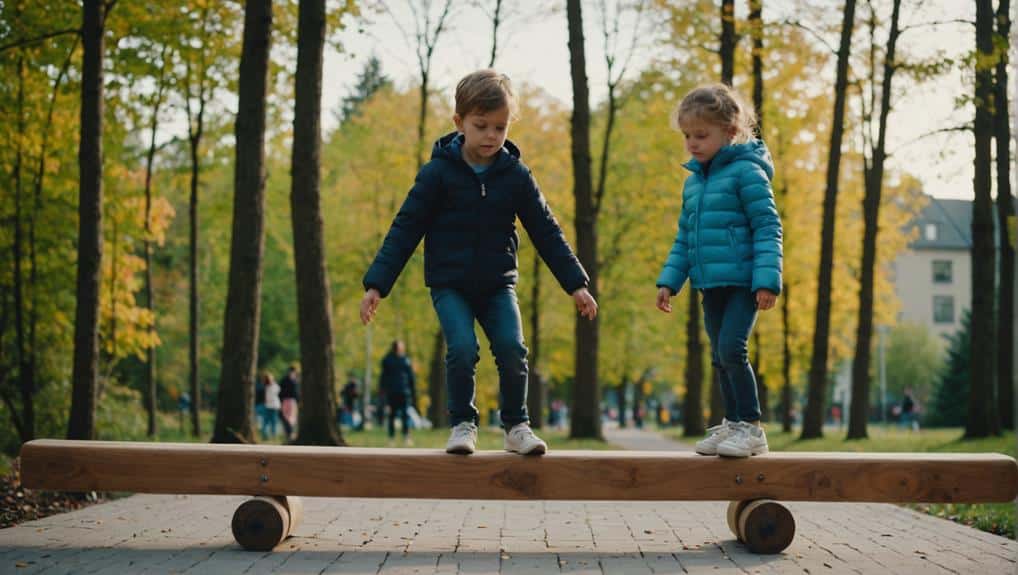
Recognizing weak core muscles in young children is crucial, as these weaknesses can manifest as poor posture, decreased stability, and challenges with gross motor skills. Early recognition is pivotal for proper core development, allowing interventions to strengthen these muscles and prevent potential long-term issues.
Signs of a weak core in children may include a noticeable slouch, struggling to sit upright, and difficulties with balance. These symptoms indicate that the child’s core muscles may need strengthening. Consequently, identifying these signs early can be critical in fostering healthy physical development in children.
The table below summarizes the signs of weak core muscles and the implications if not addressed:
| Signs of Weak Core | Implications, if Not Addressed |
|---|---|
| Noticeable slouching | Poor posture |
| She struggles to sit upright | Decreased stability |
| Difficulty with balance | Challenges with gross motor skills |
While recognizing signs of a weak core is important, it’s equally essential to understand that these signs should be consistently present, not just as the result of a child being tired or having an ‘off’ day. When in doubt, always consult with a healthcare professional.
Fun Core Strengthening Activities
Incorporating core strengthening activities into a child’s routine need not be mundane. Our focus now shifts to ‘Fun Core Strengthening Activities,’ which include No-Equipment Core Exercises, Game-Based Core Activities, and Playground Equipment Exercises. These activities are designed to engage children playfully and effectively build their core strength in diverse settings.
No Equipment Core Exercises
Harnessing the power of no-equipment core exercises, young children can engage in fun activities such as stretching, crab walks, planks, side planks, and knee lifts sitting in one chair to bolster their core strength. These simple yet potent activities for toddlers significantly contribute to their physical development. They are easily integrated into a child’s daily routine, promoting balance, stability, and, importantly, the child’s core strength.
Occupational therapy practitioners often recommend these exercises, which foster core strength and motor skills without specific equipment. They are suitable for preschool to middle school-aged children, making them widely accessible and adaptable.
Among the exercises, the following are particularly effective:
- Stretching: This fundamental exercise enhances flexibility and sets a solid foundation for physical activity.
- Crab Walks: This fun activity engages the entire body, explicitly emphasizing core and upper body strength.
Game-Based Core Activities
Shifting the focus to game-based core activities, these fun and engaging exercises offer a unique approach to strengthening core muscles in young children through play and movement. These Core Strengthening Activities are designed to be enjoyable and captivating, making the process of muscle building less tasking and more exciting for children.
Incorporating games into core exercises can potently motivate children to stay active while simultaneously building their strength. The notion of ‘Fun Core‘—the amalgamation of fun and core muscle building—helps improve balance, stability, and overall physical health, creating a positive ripple effect on a child’s growth and development.
Game-based core activities benefit muscle development and enhance young children’s motor skill development and coordination. They allow kids to master movement patterns and build motor skills essential to their overall physical and cognitive development. Pediatric OTs often use these games in therapy sessions to help children develop these skills in a playful, less intimidating environment.
Playground Equipment Exercises
Using playground equipment for core strengthening exercises presents various opportunities for young children to have fun and develop their core muscles simultaneously. Children naturally engage in motor activities on the playground that promote core strength and postural stability. Playground activities foster physical health and are instrumental in muscle development, particularly the core muscles crucial for a child’s motor development and overall physical fitness.
The following exercises on playground equipment are great for core strengthening:
- Swinging on monkey bars engages the core muscles and improves strength. It also enhances hand-eye coordination and upper-body strength.
- Disc swings: They require core stabilization to maintain balance. This helps to strengthen the muscles around the spine and abdomen, improving postural stability.
Incorporating these exercises into a child’s play routine makes exercise fun and contributes significantly to physical development. Encouraging children to use playground equipment for these activities can foster an environment that promotes fun and fitness, aiding their journey to developing strong core muscles.
Indoor Core Strengthening Exercises
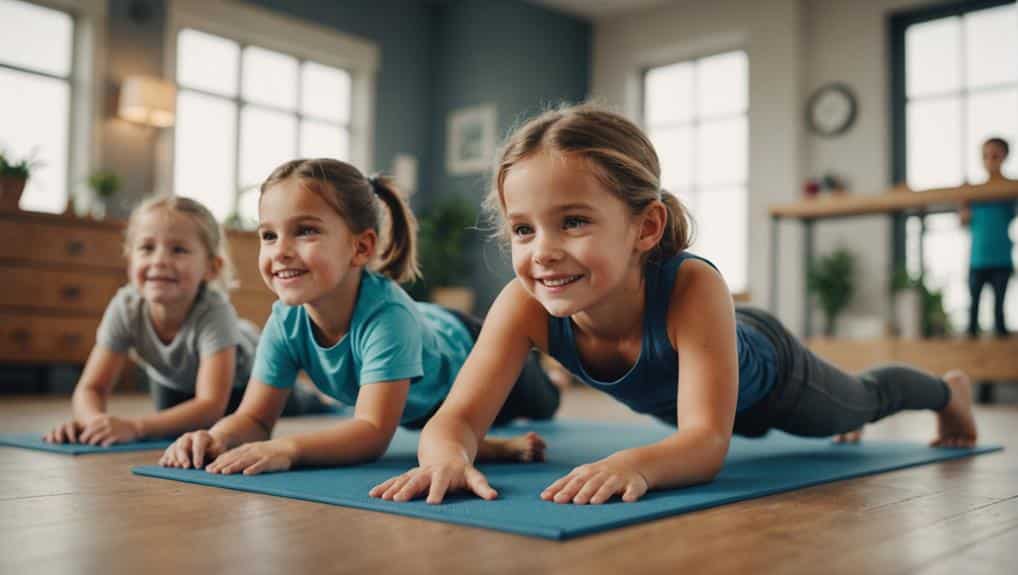
Indoor core strengthening exercises, designed specifically for young children, can be enjoyable and advantageous. These activities, which can be performed without equipment, focus on bodyweight exercises targeting the core muscles. By incorporating these exercises into a child’s routine, we can effectively enhance their stability, balance, and overall physical development.
Fun Bodyweight Exercises
Bodyweight exercises, such as planks, leg lifts, and bridges, are an effective and enjoyable way to strengthen core muscles in young children. These indoor activities not only contribute to core strength but also help to improve balance, stability, and posture. They are easy to incorporate into a child’s daily routine and can be carried out without special equipment in restricted-space areas at home.
The consistent practice of these bodyweight exercises can yield significant benefits for young children. Here are three simple yet effective exercises that can be performed indoors:
- Plank: An entire body workout that primarily strengthens the core. It also helps to enhance balance and posture.
- Leg Lifts: This exercise targets the lower abdominal muscles, aiding in core strength development.
Equipment-Free Activities
How can young children strengthen their core muscles without needing any equipment? The answer lies in simple, indoor, core-strengthening exercises that can be easily integrated into their daily routines. These equipment-free activities primarily involve engaging the core muscles, which are pivotal for stability and overall physical development.
Planks, for instance, are an excellent exercise for young children to enhance their core strength. They engage multiple muscle groups simultaneously by holding the body straight from head to foot. Leg lifts, on the other hand, target the lower abdomen and back muscles, further building core stability. Similarly, bridges help strengthen the lower back and hips and engage the core.
For maximum effectiveness, these exercises should be performed in a controlled, slow manner. Encourage children to focus on their breathing and muscle movement during these activities. This improves core strength and fosters body awareness, an essential aspect of physical development.
Incorporating these indoor, equipment-free activities into young children’s routines can build a solid core foundation, ultimately supporting their overall physical development.
Outdoor Core Strengthening Activities
Numerous outdoor activities, such as climbing trees, playing in jungle gyms, running around in open spaces, engaging in hopscotch, jumping rope, playing catch, swimming, riding bikes, scooters, and skateboards, and exploring nature, can significantly contribute to strengthening the core muscles in young children. These activities provide a source of fun and entertainment and play a pivotal role in enhancing the core strength of young children and facilitating their overall physical development.
Outdoor activities that can be beneficial for young children’s core strengths include:
- Swimming: Water resistance in swimming pools provides a safe and enjoyable way to work on core strength, balance, and coordination.
- Riding bikes, scooters, or skateboards engages the core muscles, improves balance, and promotes gross motor skill development.
Incorporating these outdoor activities into a child’s routine can improve their core strength, contribute to physical health, and foster a love for outdoor play.
Core Strengthening Games for Kids
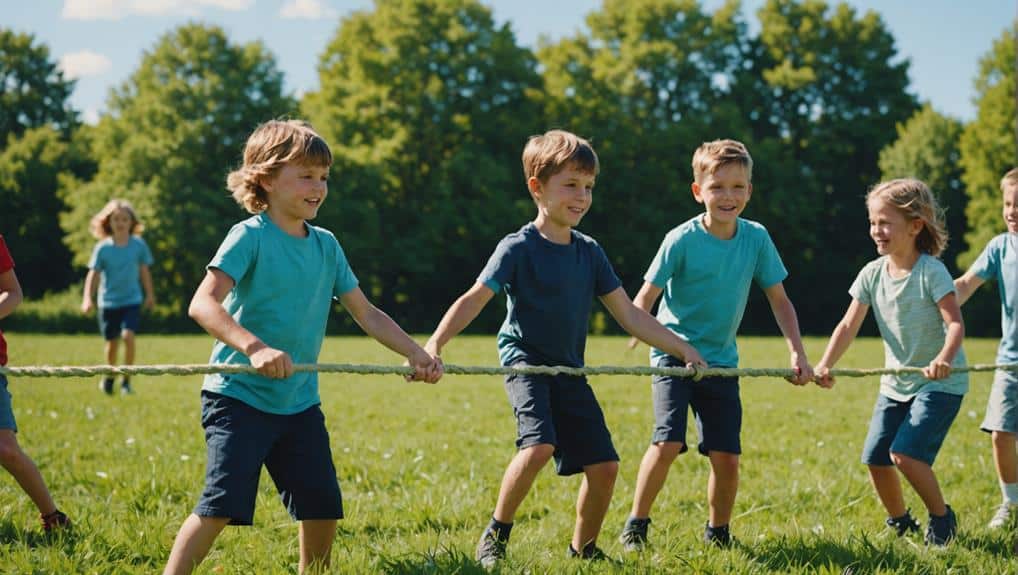
Engaging children in core-strengthening games, such as twister, hop ball bounciTwister balloon kicks, presents an enjoyable and interactive approach to enhancing their muscle strength. These games have been designed to bolster a child’s core strength and promote balance, coordination, and stability—critical elements of overall physical development.
| Core Strengthening Games | Benefits |
|---|---|
| Twister | Enhances balance and coordination while strengthening the core |
| Hop Ball Bouncing | Stimulates core muscles and promotes stability |
| Balloon Kicks | Strengthens core and improves motor skills |
Playground equipment like swings, monkey bars, and gliders present additional opportunities for play activities that strengthen the core. By transforming these core-strengthening games into a form of play, kids are more likely to participate and enjoy the process, making it a sustainable part of their daily routine. As a result, they can reap multifaceted benefits, including improved muscle strength, enhanced balance, and better coordination.
Advanced Core Strengthening Exercises
Pushing the boundaries of their physical capabilities, children can participate in advanced core strengthening exercises that aim to challenge their core muscles beyond basic movements. These exercises improve core stability and enhance balance and overall strength in young children. This progression in physical development allows them to tackle more intricate physical tasks with greater ease and confidence.
To integrate these advanced exercises into a child’s routine, consider the following activities, which are designed to challenge and stimulate the core muscles:
- Rock wall climbing: This activity strengthens the entire core as children use their abdominal muscles and back muscles to climb.
- Climbing up a slide: This nontraditional slide use forces children to engage their core muscles more intensively than in ordinary play.
When incorporating these advanced exercises, monitoring children closely is crucial to guarantee safety and proper form. This will allow us to promote their physical development while safeguarding their well-being.
Maintaining Core Strength Progress
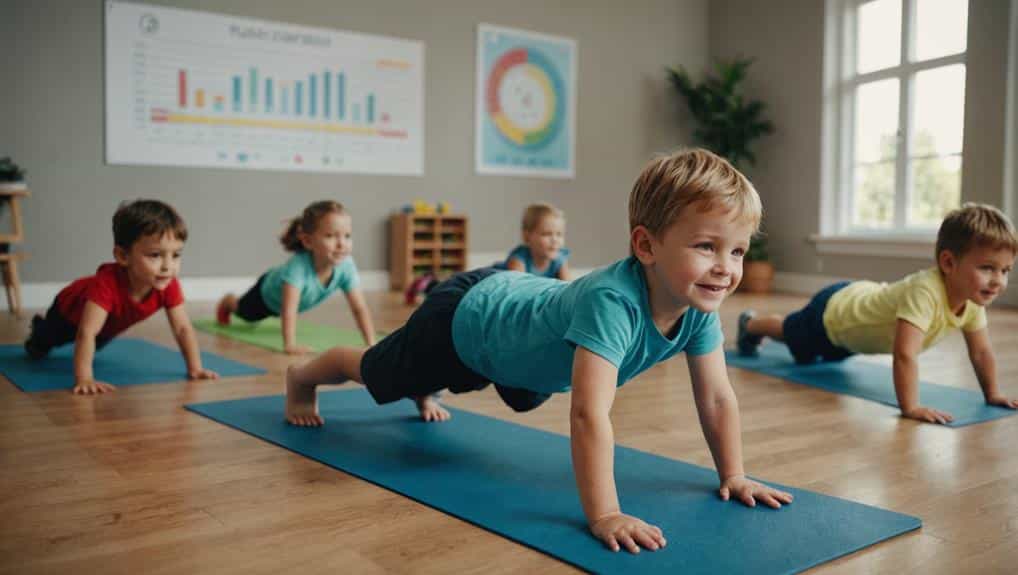
Engaging them consistently in core strengthening tasks is vital to ensure the sustained advancement of core muscle growth in young children. Regular participation in such exercises enhances core strength and prevents any decline in progress. The key to maintaining excitement for these tasks is their presentation; they should be enjoyable, captivating, and tailored to meet the child’s needs.
Monitoring progress is another crucial aspect of sustaining core strength in young children. Regular evaluations provide insights into the tasks’ effectiveness and whether they need adjustments for greater efficacy. Establishing a schedule around these exercises can also greatly aid in maintaining and enhancing core muscle development.
Here is a simple table illustrating the connection between consistent core strengthening activities and progress:
| Consistent Tasks | Progress |
|---|---|
| Core workouts | Enhanced core strength |
| Enjoyable, captivating tasks | Continuous enthusiasm |
| Establishing a schedule | Ongoing improvement |
Frequently Asked Questions
Why Build Essential Core Activities in a Child?
To build core strength in a child, encourage activities like snake curls, tightrope walking, and bridge making. Also, promote outdoor play involving climbing trees and jungle gyms for increased core muscle development.
How Do You Exercise a Ball for Core Strengthening for Kids?
To exercise a ball for core strengthening in children, encourage activities like rolling, bouncing, and active sitting on the ball. These fun movements effectively engage and strengthen deep core muscles, improving balance and posture.
How to Build a Toddler Core?
To build a toddler’s core, incorporate crawling, climbing, and jumping exercises. Play with push/pull toys, roll on the floor, and do balance exercises. Activities involving reaching, stretching, and twisting can also help.
What Causes Poor Core Strength in Children?
Poor core strength in children can result from increased sedentary lifestyles, limited outdoor play, reduced belly time, and changes in playground equipment. This can affect their posture, balance, and overall motor skills.

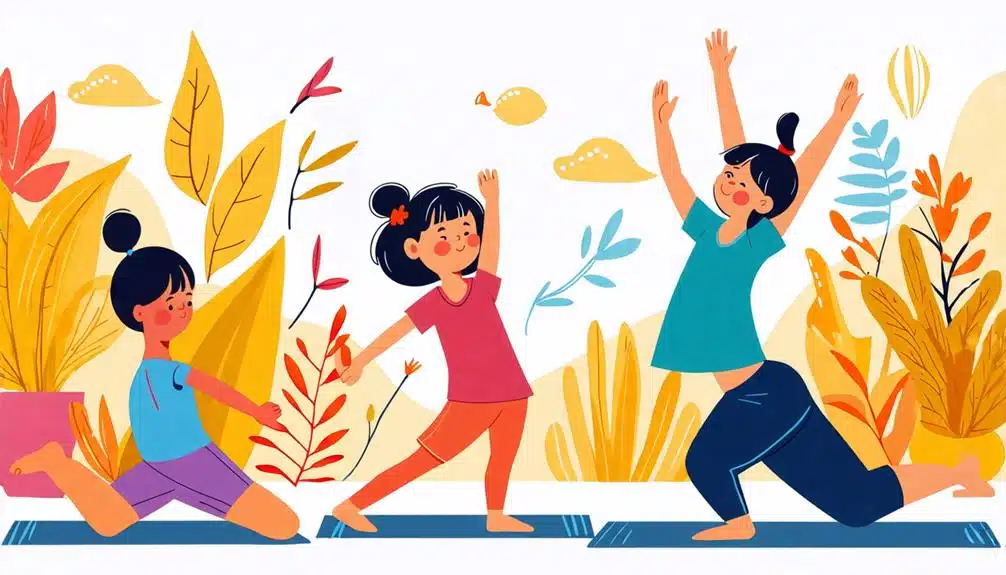
Recent Comments